Bacalar Paddle Marathon
Editor's Note: This is the third of three articles on Laguna Bacalar by Bacalar resident Scott Wallace (see links to the other two at the end of the article). The piece highlights the experiences of two teams of women paddlers (two women shared each board). Each team paddled in the 74-kilometer marathon race that took place at Laguna Bacalar on the Yucatan Peninsula on May 1st and 2nd, 2014. Scott was one of two support personnel who accompanied the teams by motor boat during the two days. Here is his recounting of the women athletes' adventure.
Pre-Dawn Wind and Rain
A 20-knot wind and rain are on the starboard stern as we motor north in the predawn light. While we are very grateful for the foul-weather gear we have brought along, it will turn out that the start of the day is not a portent for the remainder of it. But, wind and rain accompany us for most of the fast, forty-minute ride from south of Bacalar pueblo to the far north end of Laguna Bacalar, which is the starting point of Bacalar's inaugural seventy-four kilometer paddle marathon.
Seventy-four kilometers is a very long way to paddle, even spread across two days. The total time on the water is considerable. Over eight hours in a kayak and nearly sixteen hours on a stand-up paddleboard (SUP) makes for a physically demanding marathon. All those hours are spent with wet hands gripping a hard paddle handle, legs and back in constant tension, and torso rhythmically straining to exert force on water. Such effort takes a toll.
The Marathon Begins
Day One starts at the lake's northern end in Pedro Santos and ends at the Balneario Aseradero in Bacalar, a forty-one kilometer run as the crow flies. Day Two starts at the same balneario , this time with sore backs and hands, and runs to the lake's southern-most point at Xul Ha and back, a thirty-three kilometer round trip.
It is now Friday morning at 8:00 AM. As the start time approaches, the twelve paddle marathon entrants chat with friends and family, check equipment, warm up, and take some personal moments of pre-race preparation. The wind remains light from the southeast but there is no longer rain. It is chilly and a bit hazy. Those of us on the support crew stow the foul weather gear and prepare for our passenger-paddlers to board. Today and tomorrow, we will accompany the two SUP teams as support boat and transport for the paddlers. We will also transport their gear that is not on the boards. Our SUP teams are women from Cozumel and from Mahahual. These paddlers have considerable experience on stand-up boards and have trained hard for this strenuous event.
Shortly, organizers make final announcements and racers with their kayaks and boards enter the water and mill about the start. We are looking at three kayaks and five paddle boards. Two of the stand-up paddleboards are raced by pairs of paddlers who alternate time on the board. It is just after 8:15 AM when the starting horn blows and the paddlers head into the wind and away from the starting line. There is not a lot of sprinting in this race. Everyone is settled in for the long haul and, if someone was forgetting, the low chop and headwinds are a constant reminder of the need to conserve energy.
The first leg of the race is about eight kilometers and stretches from the lake's northernmost tip until the dogleg to the right and west. The dogleg itself is four kilometers and is followed by two long stretches to the south. The first is fifteen kilometers between Pedro Santos and Villas EcoTucan, and the second is fourteen kilometers from EcoTucan to the Balneario Aseradero in Bacalar pueblo. These distances are not what the racers travel. Every racer will go as much as ten percent further due to shoreline irregularities and winds.
Paddling in Paradise
Within fifteen minutes, the field spreads out. The kayaks are making three times the speed of the paddleboards and are already well away. The individual SUP paddlers are ahead of us, making better speed than our two teams of paddlers. After months of preparation, it is time to find the rhythm of paddling, to settle in, and to enjoy the lake. Here at the north end, Laguna Bacalar is still a bit tea-brown in color from seasonal runoff, but the bottom is clearly visible in two meters of water. The paddle teams stay close to the shore seeking relief from the five to ten knots of wind. Staying close to the shore has the added benefit of feeling like you are literally in the middle of the jungle.
The jungle overhangs the western shoreline and along almost the entire length of the race. To our delight, bromeliads and orchids are putting on their spring growth in the mangroves, making for quite a beautiful show as we go by. For meter after meter after meter, the quiet and beautiful selva displays itself. The paddlers seem to be in their own quiet world, a world of slow, physical rhythm and fluid, surrounding water, accompanied by colorful, boisterous natural beauty. The waves of the boards on the water, the vision of the racers ahead of us, the beautiful colors of the lake against the far shore... the scene is positively enchanting. Even the low drone of our motor as we idle along with the paddlers is comforting. Birds call out and fly about. In fact, within forty-five minutes the paddlers spot their first toucan and shortly after that, the first flock of parrots, about two dozen of them squawking overhead.
After an hour, our teams trade paddlers as planned, a procedure we will all become overly familiar with by the end of our two days together. Those on the boat have already had their snack and water (one to two liters per hour) and those on the SUPs prepare to board the boat. For both the starting and the stopping paddler, this involves a quick dunk in the lake for a cooling rinse off and a discreet bio-break.
Well Prepared and Well Supported
While we are with these two teams, Bacalar municipal police boats and Mexican Navy launches are monitoring the progress of the other racers, ready to offer aid as needed. Emergency response and medical personnel are standing by in the town and, though very little of the lake is accessible by land vehicle, ambulances are ready to rendezvous at various points along the length of the marathon course. The event, though sparsely attended, is very well prepared.
We are a bit more than two hours into the marathon and our teams have swapped paddlers twice. Wind continues to blow in our faces or slightly from the port, but the lake is calming down. We are a bit over five kilometers into the forty-one kilometer first day. The morning is beginning to get warmer, though it is still overcast. This is an undisguised blessing. Full sun would be very hot and, with the lake reflecting back up onto the paddlers' faces, hours of paddling would be harsh, even for those who slather on SPF 50, wear black-lensed-wrap-around sunglasses, and are well-accustomed to these conditions.
At the three hour point, with the winds picking up a bit and now blowing head on, we spend nearly thirty minutes in a heavy rainshower. Our paddlers drop to their knees to reduce their profile and continue on. It is warm enough that no one is chilled and, for the paddlers, the rain has a nice cooling effect. It also creates a kind of isolation. All of us are enjoying the beautiful pattern the rain makes on the lake surface and the raindrops striking the water make musical sounds. It is a special moment.
The Bacalar Marathon Continues
Our two teams are now at the end of the dogleg and heading down the first long stretch, which is fifteen kilometers long. The rain has stopped and we are hugging the east shore for protection from the generally southeast winds, which continue at between five and fifteen knots. In the lee of the shore and in the shallows, there is no chop and less wind. The lake here is about four kilometers wide, leaving plenty of space for the wind and waves to get rolling.
Along this eastern shore there is no jungle, few plants and very little wildlife. We see only low scrub on saskab flats with the occasional stunted mangrove. The sky is clear now and though not quite sunny, it is turning out to be a nearly perfect day for a tour of the lake. In this stretch, our quiet paddlers come upon innumerable small fish, a large fresh-water ray, a few birds, and a rather large turtle. We are now six hours into the marathon and our teams are tiring.
Near the end of this leg, we pass the Mexican Navy jungle training base. We pause for a reflective moment to look at a series of flags on rough posts embedded in the saskab that march across several kilometers of open, deep water from the base. We are still pushing into the wind as we clear the point south of the navy base and enter the long stretch to Bacalar.
The Kayaks Have Finished
We hear on our radio from the race organizers that all the kayaks have finished. Moreover, they let us know there is no wind at all in the southern part of the race course. We are still in five to ten knots of unfavorable winds, now seven hours into the paddle, and have a good fifteen kilometers to go. At our current speed, which will slack as the paddlers tire further, there simply is not enough daylight to get us to today's finish line. We have been encountering winds that the others did not. At the next paddler change over, we discuss the situation and decide to make our way another five kilometers to the take out at Villas EcoTucan.
It is a very hard five kilometers. Our teams are now quite tired, and while the southern part of the course is without breeze and the SUP paddlers ahead of us report calm, we are still very much in Bob Seger territory: against the wind. Our once-an-hour paddler swap becomes once-every-forty-minutes and the paddlers are craving food to power so much work. The sky is not yet showing signs of dusk, but the afternoon is definitely waning as we pull the boards out at EcoTucan and the paddlers make their wobbly way ashore to stow their gear. Over an evening meal, they consider their options and decide to simply omit the part of the course not covered and continue with the second day.
Day Two of the Paddle Marathon
It is a calm and beautiful day as the somewhat battered racers prepare to enter the water. For the kayakers, the primary issue is hands. Yesterday, each kayaker spent between four and a half and six hours with wet hands gripping dripping-wet paddles. In these conditions, even with kayaker gloves that cover the palm and fingers to the first knuckle, it is not possible to avoid blistering the inside of water-softened fingers. All wear adhesive tape around the fingers and over the blisters.
For the stand up paddlers, hands do not get so wet while paddling and are not so beat up. But their legs and lower backs are suffering. And for our two teams, the biggest problem now is how long they paddled yesterday. The two teams spent more hours in unfavorable weather and more time on the lake paddling than anyone else. Though they travelled fourteen fewer kilometers, they are no less tired than the other paddlers.
Everyone is anxious to get going and soon the klaxon announces the start of Day Two. The lake is putting on a show this morning, with all its shades of blue and white, and the racers head off with almost no wind. Today will take them beside the southern part of Bacalar Pueblo along the populated Costera and then by Bird Islands, currently populated with roosting cattle egrets, roseate spoonbills, great egrets and wood storks. With the sun shining, our two teams quickly decide to adjust their one-hour-on-one-hour-off schedule to thirty minute shifts. Still, the paddlers find themselves overheated and ready for a plunge at both ends of their shift change. We are hot just riding slowly along in the boat.
In less than an hour we are entering the narrower channel and the water almost explodes with color. The two teams have their rhythms established and are making very good time. There is no wind to speak of and no waves. Between the sun, the angle of the light, the shallow water (one meter) and the white bottom, it is color therapy to be just here.
In a bit, ahead, we can see the water shoal and the way bends to the west. The sky clouds up. The lake soon narrows dramatically and we are now heading into a current of about three knots. We approach the Stromatolite Rapids, which are not really rapids but a fifteen-meter-wide channel with varying depth defined by undulating growths of stromatolites forming the shoreline and the channel sides and bottom. Stromatolites are believed to be the earliest form of life on earth, a rock-like cyanobacteria from the Precambrian period 2.5 billion years ago.
This 300-meter-long channel is formed by extremely-rare, Holocene‐era stromatolites (13,000 +/- years ago) also found at other sites in and around Laguna Bacalar. It is eerily beautiful and those in the boat look forward to passing back through it on the boards when we head north on our return.
Our teams make quick work of the rapids and are soon at their southern end and heading into the next part of the lake, a four-hundred-meter wide, four-mile stretch of open water. Again, there is jungle on the west and low flats on the east, and just a hint of oncoming current. Our paddlers settle into their rhythm and over the next half hour, we pass the faster-moving kayakers returning north.
And Finally...
Two hours later, as the sky clouds up and threatens rain, we enter the north end of Xul Ha cenote and see our goal. Three kilometers ahead is the large, yellow buoy marking the southern end of the lake and our turn-around point, exactly half-way through today's race. The other SUP paddlers have rounded the mark and we pass them and chat cordially for a moment before our paddlers return to work. All are quite tired.
That said, the yellow buoy so close ahead exhilarates our paddlers. It seems to maintain a distant position for a very long time. The Xul Ha cenote is draining north in a slow current and there is a slight wind from the southeast, so the paddlers hug the western shore and work hard to make way. After too much time, the buoy is rounded and the paddlers begin the return trip north.
Following the two-hour struggle to reach the buoy, the return seems almost leisurely. With favorable wind and current, the paddlers are moving quickly again. The sun seems to sense their urgency and pours light down, providing a bit more energy for the task at hand, and making the lake's blue colors and jungle foliage sparkle, which lifts everyone's spirits.
The trip north is easier than the trip south, due to good winds and the current heading out of Xul Ha. And, of course, the racers are now paddling toward the finish. Soon, it seems, we are passing down the Rapids again and out into the next part of the lake, and on to the next, and then at last we can see Bird Islands and the finish line.
In three hours and fifteen minutes, the paddlers made their way from the Day Two starting line to the turn-around buoy. The return trip to the finish line takes but three hours and twenty minutes. Counting the day before, the teams paddled for almost sixteen hours.
As we approach the finish, after a brief consultation, the paddlers decide to double-up to cross the line. Everyone should be aboard for this victory!
****
The author would like to extend very special thanks to Laura Chisolm and Nicole Ferroni of Cozumel and Carolyn Thomas and Simone Kiedaisch of Mahahual. And, of course, to Bacalar resident and captain Jimmie Clarizio for the two-day boat ride down and up Laguna Bacalar.
The first article, Laguna Bacalar, Special Waters
The second article, Laguna Bacalar, Back in Time




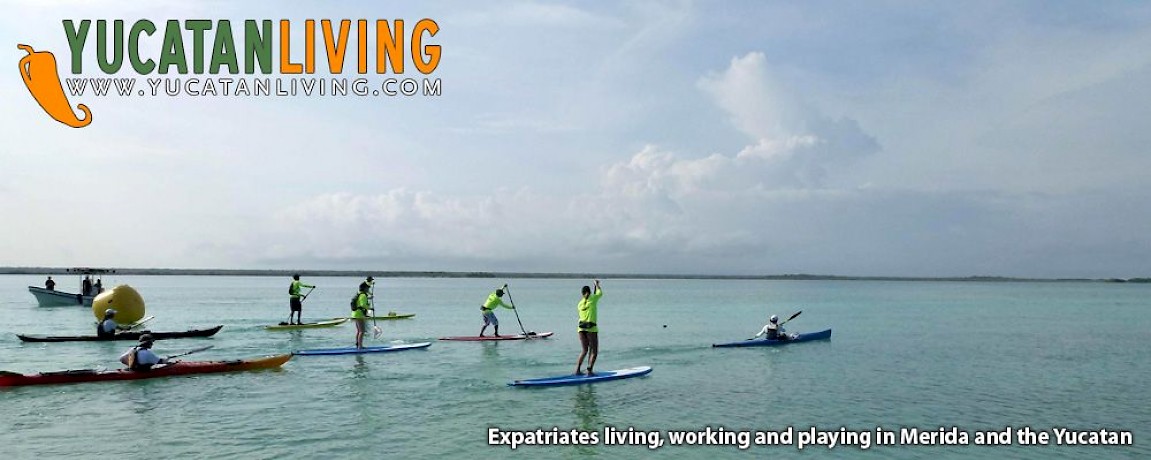


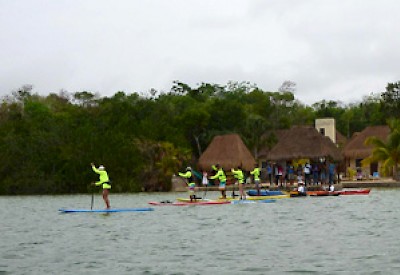
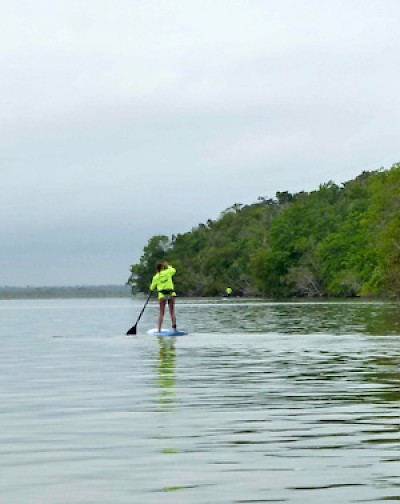
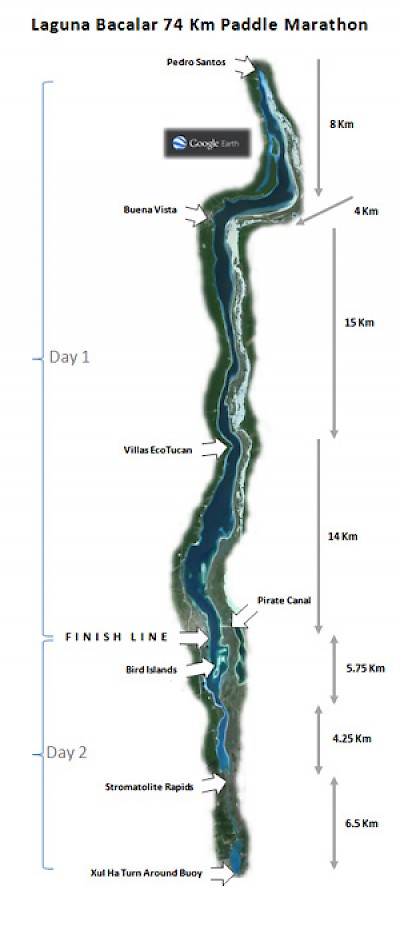
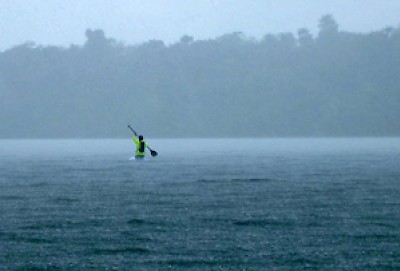
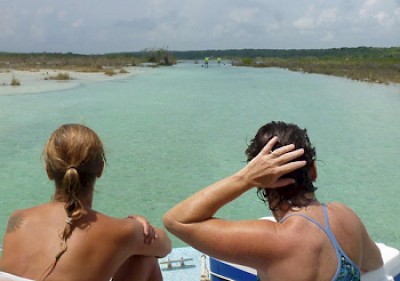
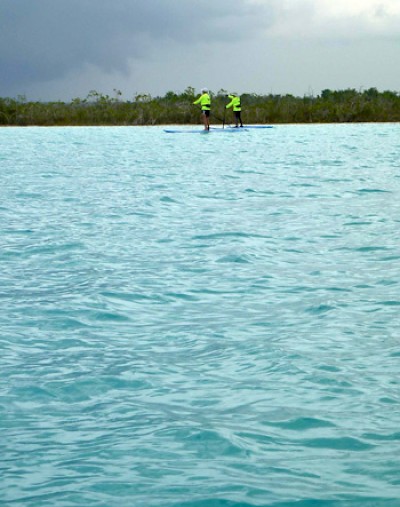
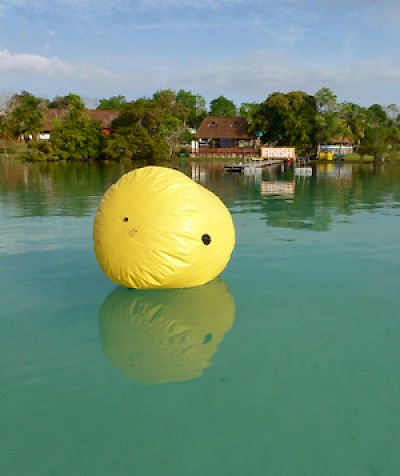

Comments
Carolyn Fairris Thomas 12 years ago
Thank you, Scott! What a wonderfully entertaining and helpful support team you and Jimmie made for our teams. GREAT article! See you next year...we will bring our own chicken and egg sandwiches next time.
Reply
Bill & Veronica Howes 12 years ago
Should i ever reach this particular destination, I hope to be riding a horse.
Bill
ps.My congratulations to those hardy gringos entering such a race.
Reply
(0 to 2 comments)